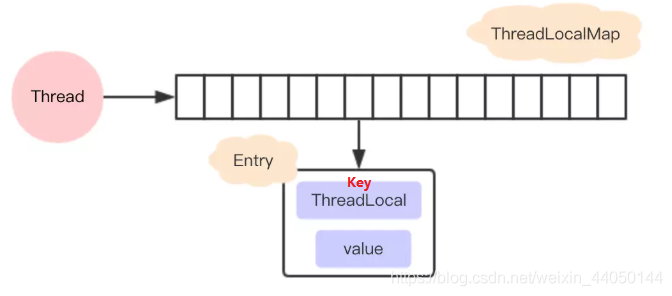ThreadLocal,即线程变量,是一个以****ThreadLocal对象为键、任意对象为值的存储结构。这个结构被附带在线程上,也就是说一个线程可以根据一个ThreadLocal对象查询到绑定在这个线程上的一个值。目的就是为了让线程能够有自己的变量
可以通过set(T)方法来设置一个值,在当前线程下再通过get()方法获取到原先设置的值。
/**
* Sets the current thread's copy of this thread-local variable
* to the specified value. Most subclasses will have no need to
* override this method, relying solely on the {@link #initialValue}
* method to set the values of thread-locals.
*
* @param value the value to be stored in the current thread's copy of
* this thread-local.
*/
public void set(T value) {
//获取当前线程
Thread t = Thread.currentThread();
//得到线程的ThredLocalMap
ThreadLocalMap map = getMap(t);
//如果map不为空,则将当前线程的对象作为key,传进来的参数作为value存储
if (map != null)
map.set(this, value);
else
createMap(t, value);
}
看一下ThredLocalMap是什么:
static class ThreadLocalMap {
/**
* The entries in this hash map extend WeakReference, using
* its main ref field as the key (which is always a
* ThreadLocal object). Note that null keys (i.e. entry.get()
* == null) mean that the key is no longer referenced, so the
* entry can be expunged from table. Such entries are referred to
* as "stale entries" in the code that follows.
*/
static class Entry extends WeakReference<ThreadLocal<?>> {
/** The value associated with this ThreadLocal. */
Object value;
Entry(ThreadLocal<?> k, Object v) {
super(k);
value = v;
}
}
.......
看到这是ThreadLocal的一个内部类,使用Entry类进行存储。K是我们的ThredLocal对象。
总结:Thread为每个线程维护了ThreadLocalMap这么一个Map,而ThreadLocalMap的key是LocalThread对象本身,value则是要存储的对象
再来看下get方法:
public T get() {
Thread t = Thread.currentThread();
ThreadLocalMap map = getMap(t);
if (map != null) {
ThreadLocalMap.Entry e = map.getEntry(this);
if (e != null) {
@SuppressWarnings("unchecked")
T result = (T)e.value;
return result;
}
}
return setInitialValue();
}
拿到这个entry的value。
ThreadLocal本身并不存值,它只是作为ThreadLocalMap的key,来获取value,因此能实现数据隔离。
注意:由于ThreadLocalMap的生命周期和Thread一样长,因此要手动remove掉对应的key,不然会造成内存泄露。
使用场景:
1.管理Connection,尤其是管理数据库连接。
频繁创建和关闭connection是一件很耗时的操作,因此要用到数据库连接池。ThreadLocal可以很好的管理数据库连接,因为它能够实现当前线程的操作都是用同一个Connection,保证了事务!
public class ConnectionUtil {
private static Logger logger = LoggerFactory.getLogger(ConnectionUtil.class);
//数据库连接池
private static BasicDataSource dataSource;
//为不同的线程管理连接
private static ThreadLocal<Connection> local;
static {
BufferedReader br = null;
Properties ipp_prop = new Properties();
try {
String propertiesurl = System.getProperty("user.dir") + "/ipp_parser.properties";
br = new BufferedReader(new InputStreamReader(new FileInputStream(new File(propertiesurl)), "utf-8"));
ipp_prop.load(br);
br.close();
} catch (Exception e1) {
e1.printStackTrace();
}
dataSource = new BasicDataSource();
dataSource.setDriverClassName(ipp_prop.getProperty("db.driver"));
dataSource.setUrl(ipp_prop.getProperty("db.url"));
dataSource.setUsername(ipp_prop.getProperty("db.user"));
dataSource.setPassword(ipp_prop.getProperty("db.password"));
//初始连接
dataSource.setInitialSize(Integer.parseInt(ipp_prop.getProperty("db.initsize")));
//最大连接
dataSource.setMaxTotal(Integer.parseInt(ipp_prop.getProperty("db.maxtotal")));
//最长等待时间
dataSource.setMaxWaitMillis(Integer.parseInt(ipp_prop.getProperty("db.maxwait")));
//最小空闲
dataSource.setMinIdle(Integer.parseInt(ipp_prop.getProperty("db.minidle")));
dataSource.setMaxIdle(Integer.parseInt(ipp_prop.getProperty("db.maxidle")));
//初始化线程池本地
local = new ThreadLocal<>();/**得到连接
* @return
* @throws SQLException
*/
public static Connection getOracleConnection() throws SQLException {
//获取Connection对象
Connection connection = dataSource.getConnection();
//把Connection放进local里
local.set(connection);
logger.info("get oracleConnection");
return connection;
}
public static void closeOracleConnection(){
Connection connection = local.get();
try {
if (connection != null) {
//设置自动提交
connection.setAutoCommit(true);
//连接还给连接池
connection.close();
local.remove();
logger.info("close oracleConnection");
}
} catch (SQLException e) {
e.printStackTrace();
}
}
}









